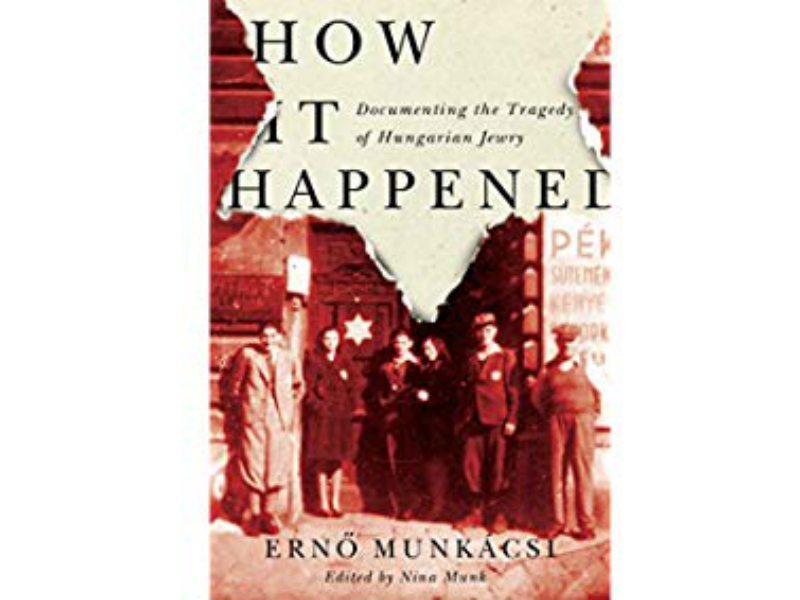Given my Hungarian roots, I was intrigued by the recently published book How it Happened: Documenting the Tragedy of Hungarian Jewry written by Erno Munkácsi. Munkácsi, a cousin of the late Peter Munk, survived the Second World War in Budapest, as did my mother.
How it Happened covers a short time period: Mar. 19, 1944, the date Germany invaded Hungary, to Aug. 1944. At the time of the German invasion, approximately 800,000 Jews lived in Hungary, representing eight per cent of the overall population. Budapest had over 200,000 Jews.
At the onset of the war, my mother and her siblings had been sent to Budapest by their parents on the assumption that they had a better chance to survive the war there rather than a small Slovak village. They were in their late teens or early 20s, and their parents were right. All the children survived, while their parents, who remained behind in Slovakia, ended up in Auschwitz.
When I used to ask my mother how she and her siblings managed to survive, she simply said they all assumed Christian identities using forged papers. Having read Munkácsi’s book, detailing critical and controversial issues that the Jewish community had to deal with in 1944, I am now not sure it was as simple or easy as my mother put it.
The most controversial issue raised by Munkácsi is the role of the Judenrat or Jewish Council. The infamous Adolf Eichmann, who was in charge of dealing with Hungarian Jews, ordered that a Jewish Council be established in Budapest to be the administrative interface between the Germans and the Jews. Munkácsi was a member of the Jewish council.
The Jewish Council was given orders by the Germans, such as to ghettoize the Jewish population or the wearing of the yellow star, which the Jewish Council carried out. Deportations began soon after the German invasion, under the pretext that the Jews were being sent to Germany to be labourers. In fact they were going to Auschwitz. In just two months, 437,000 Jews, mostly from the countryside, were deported.
Did the Jewish Council protect the Jewish community as best it could or was it inadvertently complicit with the Germans? Was a better outcome achieved for the Hungarian Jews because of the Jewish Council’s efforts? Munkácsi comments that, incredible at it may seem today, before May 1944, Hungarian Jewry had no idea of the horrors of the concentration camps. Eichmann meanwhile had told the Jewish Council the big lie that no harm would come to the Jews if they cooperated.
But perhaps resistance may have been a better strategy, especially given the large size of the Jewish population compared to the limited German military resources in Hungary. One can speculate that, had there been resistance, deportations may have not been as successful. Certainly some accused the Jewish Council of betraying its own people or at least of being extremely naïve about where the Jews were being sent.
(Munkácsi captures the Jewish Council controversy with dark humour. A Jew is woken up in the middle of the night by a banging on his door. “Who’s there?” he calls out. “The Gestapo” comes the answer. “Thank God” says the Jew, with obvious relief, “I thought it was the Jewish Council!”)
READ: VALE: A UNIVERSAL LESSON FROM THE HOLOCAUST
Munkácsi also highlights the role of the Hungarian churches that impacted events in 1944. He writes that as a response to anti-Semitism, after the First World War, there was a large scale conversion of Hungarian Jews to Christianity. This rush to convert eased up until the rise of Hitler, and the enactment of anti-Jewish laws in Hungary, when conversions resumed on a large scale. By 1944, Munkácsi describes long lines of Jews waiting for their conversion to be recognized by the rabbinate.
These conversions had the effect of drawing the churches into the events of 1944. The churches were eager to differentiate the treatment of converted Jews from the Jewish community and petitioned the government to exempt converts from the anti-Jewish laws. As the churches became aware of the real fate of the deported Jews, they put pressure on the Hungarian government to stop the deportations.
Facing the fact that the war was lost, and with pressure from the Jewish Council, the churches and neutral countries like Sweden, on July 6, 1944 the Hungarian government ordered the deportations to stop. Thus it appeared that at least the Jews of Budapest would be saved. But it was not to be. In Oct. 1944, a more severe fascist government came into power in Hungary. This new government organized the execution of some 100,000 more Jews.
Budapest fell to the Russians in Jan. 1945. A core Jewish population did survive in Budapest – my mother being one – which forms the basis of the community even today. Having read Munkácsi’s book, detailing the complexity and dangers of the daily lives of Jews in Hungary, I am even more impressed that my mother and all her siblings survived that terrible time.
